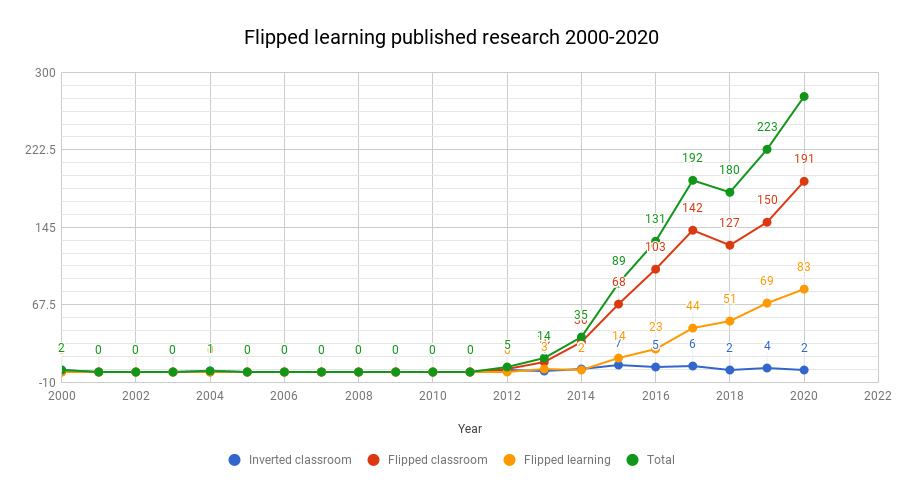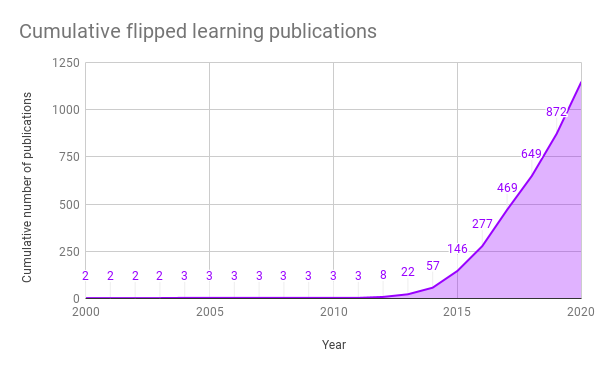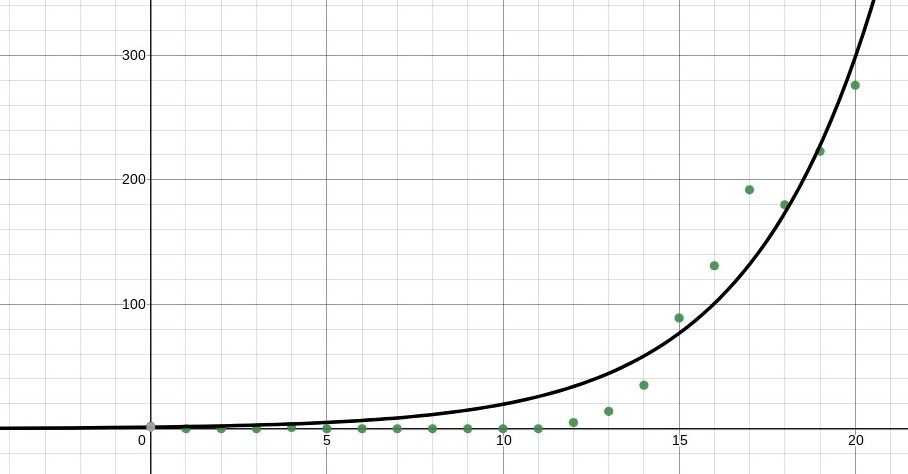How much research has been done on flipped learning? The 2021 update

It's the middle of June, which means it's time for my annual update on how much research has been done on flipped learning. Back in 2016, I was writing my book, and I needed to do a literature review. At the same time, increasing numbers of people were also asking me about flipped learning research, specifically whether there was any. Many of those people assumed the answer was zero. So, to kick-start the literature review and to give a real answer to the skeptics, I wrote this article to have a look at the publication data from 2000 through 2015 and examine the trends. Every year since then I've done an update in the middle of the summer to add on the previous year. Here are the updates with the data for 2016, 2017, 2018, and 2019. Today I'm adding on the data for 2020.
I've been thinking about this day since Fall 2020 semester started, wondering what the results would look like. Many faculty essentially took the pandemic year off from research altogether to focus on self-care and core job duties like teaching — rightfully so, and I was one of them. Publications on flipped learning ticked downward for the first time in 2018 but then came roaring back in 2019; would the upward trajectory continue? Or would there be a massive drop-off due to the pandemic? I don't go on Twitter often these days but I asked people to make a guess:
Make a guess: How much less/greater was the number of peer-reviewed publications on flipped learning in 2020 compared to 2019? For example +10 would mean 10 more in 2020 vs 2019, -10 would mean 10 fewer in 2020 vs. 2019.
— Robert Talbert (@RobertTalbert) June 15, 2021
Let's see how things actually turned out.
To remind everyone, the way I do this is I go to the ERIC database at http://eric.ed.gov. Then I do three advanced searches. The first is:
(title:"flipped learning" or abstract:"flipped learning") and (pubyear:2020)This returns all the articles published in 2020 with "flipped learning" in the title or the abstract. And I make sure to check the "Peer reviewed only" box to filter out things like op-eds and blog posts. Once the search is done, I write down the number of hits it brings back. Then the other two searches are the same as above except replace "flipped learning" with its two most common synonyms, flipped classroom and inverted classroom. Then add all three of the numbers.
As I freely acknowledge each year: Yeah, I know this is a very rough metric. It doesn't use other databases; it double- or triple-counts articles that come up in two or all three of the searches; and just because an article has one of those terms in the title or abstract doesn't mean the article is about that concept. And so on. But in terms of a quick-and-dirty, back-of-the-napkin quantification of research output, you could do worse. And anyway, it's the process I've used for five years now, so I'm sticking with it so I can compare apples to apples.
So: How did 2020 go? Here are the results with a comparison to 2019:
| Search term | Publications in 2020 | Difference from 2019 |
|---|---|---|
| Flipped classroom | 191 | +41 |
| Flipped learning | 83 | +14 |
| Inverted classroom | 2 | -2 |
| Total: | 276 | +53 |
So the majority in my Twitter poll was correct: Not only was there not a dropoff in 2020, it was the third-biggest single-year jump on record. (Second place is 2015 when the difference was +54; first place is 2017 with a jump of +61.) Here's the historical data, starting back with the first flipped learning publications in 2000 up through 2020:

(The top-right green data point is the 2020 count of 276.) Even more dramatic is the graph of the cumulative publication count with 2020's data in it:

The top-right data point didn't get labelled, but it's 1148. Savor that for a moment: Over 1100 peer-reviewed articles on flipped learning out there, as of the end of 2020, with more on the way in 2021.
I put the yearly (not cumulative) data into Desmos to generate an exponential regression:

Pretty good fit, I'd say. In fact Desmos gives an exponential regression formula of $y= 1.29933(1.3124)^x$, with an $R^2$ of 0.9425.
Time for some analysis/speculation. I have to admit, just as I didn't do much research of my own in 2020, I haven't read much of these recent publications, so I am woefully unaware of the specifics of what is being published. But this never stopped me before, so:
- To put that exponential regression in perspective, it's saying that flipped learning research is growing at a rate of 31.24% per year as of right now. If that were the interest rate on a financial instrument, you might be tempted to sell everything you own and invest in it.
- However, to temper our expectations, remember that the academic publishing process is glacially slow, therefore it could be that this year, in 2021, is when we'll see the big slowdown in publications due to the pandemic year. I re-ran the searches, and so far the total number is 72 publications through the first half of 2021. That's about the same as last year at this time (69 publications in 2020 through June 15). You can't read too much into that number, because there's usually an acceleration in publications in the latter half of the year since faculty often write up research in the summer. But it does seem like people are chugging right along doing research in flipped learning despite the pandemic year.
- Again, I haven't read much (any?) of these 2020 publications, but scanning through the abstracts, they seem to confirm an observation I'd made before, that research on flipped learning is shifting away from action research toward more conceptual articles. I noticed several meta-analyses and bibliometric studies in the mix, along with theoretical articles connecting flipped learning to other conceptual frameworks and some interesting-looking studies on flipped learning in non-Western cultures. This makes sense and I welcome it.
And as always, remember that quality and quantity are very different things. It's good to see research output increase exponentially yet again; it's more data that flipped learning is not a fad or a buzzword. But we still have to approach this research critically and call it out its flaws, like any research.
But in terms of being an active, fast-growing area of research, flipped learning continued to be in that space in 2020 despite everything. It's not a fad, not an edu-buzzword, not the flavor of the month — it's a philosophy that is particularly well in tune with the needs of both pandemic-era and post-pandemic teaching and learning, and I suspect that even if there's a dropoff in productivity this year, we'll be hearing even more from the flipped learning universe in the months and years to come.


